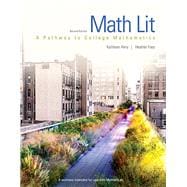NOTE: Before purchasing, check with your instructor to ensure you select the correct ISBN. Several versions of Pearson's MyLab & Mastering products exist for each title, and registrations are not transferable. To register for and use Pearson's MyLab & Mastering products, you may also need a Course ID, which your instructor will provide.
Used books, rentals, and purchases made outside of Pearson
If purchasing or renting from companies other than Pearson, the access codes for Pearson's MyLab & Mastering products may not be included, may be incorrect, or may be previously redeemed. Check with the seller before completing your purchase.
This text provides a one-semester alternative to the traditional two-semester developmental algebra sequence for non-STEM (Science, Technology, Engineering, and Math) students. This new approach offers an accelerated pathway to college readiness through developmental math, preparing non-STEM students to move directly into liberal arts math or introductory statistics, while also preparing STEM students for intermediate algebra.
This package includes MyMathLab®.
An Accelerated Pathway through Developmental Math
Math Lit, by Kathleen Almy and Heather Foes, offers an accelerated pathway through developmental math, allowing non-STEM students to move directly into liberal arts math or introductory statistics. Through its emphasis on contextual problem solving, the Almy/Foes text and its accompanying MyMathLab® course help students gain the mathematical maturity necessary to be successful in a college-level non-STEM math class. Students work through carefully designed explorations, activities, and instruction to garner a greater conceptual understanding of the major themes of numeracy, proportional reasoning, algebraic reasoning, and functions. Enhancements in the Second Edition have increased the versatility and ease of use for students and instructors alike.
Personalize learning with MyMathLab
MyMathLab is an online homework, tutorial, and assessment program designed to work with this text to engage students and improve results. Within its structured environment, students practice what they learn, test their understanding, and pursue a personalized study plan that helps them absorb course material and understand difficult concepts.
013430408X / 9780134304083 Math Lit plus MyMath Lab -- Access Card Package
Package consists of:
- 0134433114 / 9780134433110 Math Lit
- 0321262522 / 9780321262523 MyMathLab -- Valuepack Access Card
Students can use the URL and phone number below to help answer their questions:
http://247pearsoned.custhelp.com/app/home
800-677-6337









